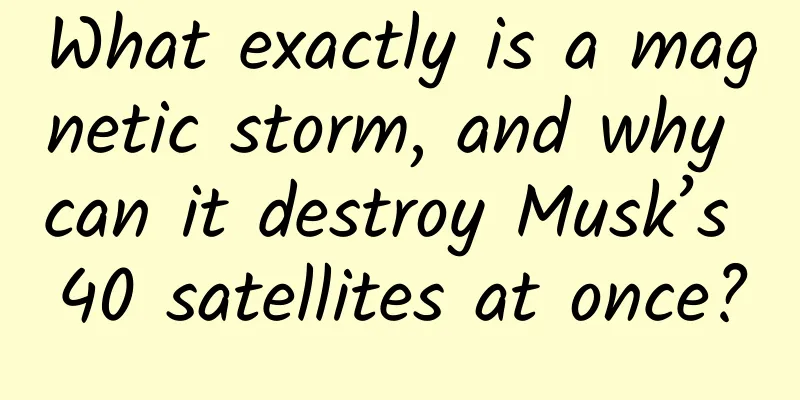What exactly is a magnetic storm, and why can it destroy Musk’s 40 satellites at once?

|
According to reports by CNN and Reuters on February 9, due to the impact of the magnetic storm, 49 Starlink satellites launched by Musk's SpaceX on February 3 have entered safety mode and are in ultra-low orbits. At least 4 of them have crashed, and the situation of other satellites is not optimistic. In fact, we have all experienced many magnetic storms. Let us understand why this magnetic storm could have caused Musk's ambitions to fail. Solar activity and magnetic storms In fact, scientists have long warned that solar activity will become more frequent starting this year. As early as last month on the 18th and 20th, there were two solar flares, which will emit a large amount of ultraviolet rays and X-rays, and will also eject a lot of plasma at high speed, all of which will have a huge impact on the earth's atmosphere. Among them, ultraviolet rays and X-rays will ionize the top of the earth's atmosphere, causing temporary radio interruptions. Tuchong Creative In addition, the sun normally releases high-speed charged particles, also known as "solar wind". Normally, the solar wind is relatively "gentle" and easily deflected by the Earth's magnetic field. It has no chance of harming life on Earth and has little impact on satellites and communications. However, if a solar flare erupts, a strong solar wind may occur. In addition to directly damaging satellites, it may also cause large-scale disturbances in the magnetic field near the Earth. This is what we often call a magnetic storm, which often leads to communication interference, atmospheric expansion due to heat, and may also cause power outages. Solar wind is deflected by the Earth's magnetic field | TuChong Creative However, there is no need to be afraid of magnetic storms. Although it is difficult to predict a specific magnetic storm, since the 18th century, sunspot activity has basically been in an 11-year cycle, and thousands or tens of thousands of magnetic storms will occur in each cycle. We have seen many magnetic storms, and in most cases, the communications of satellites in orbit will be temporarily affected, and they will not crash. But how come Musk's Starlink satellites are so fragile that all 40 satellites are "down" in the face of a mild magnetic storm? This requires talking about the impact of magnetic storms on low-orbit satellites. Why is there such a huge loss of Starlink satellites? The first is that the quality of the Starlink satellites themselves is not “strong enough”. Because the commercial satellites of the Starlink project often use some less mature new technologies in order to save costs, the reliability of these satellites is not as high as traditional satellites in the harsh space environment. Once a magnetic storm occurs, they are more likely to fail. Traditional satellites often use more reliable mature technologies | Tuchong Creative When a magnetic storm occurs, a large number of charged particles are often injected into the atmosphere, heating the atmosphere and causing it to expand. This expansion of the atmosphere brings problems. At the altitude of low-orbit satellites, the upper atmosphere is originally very thin, but when a magnetic storm occurs, the atmosphere is heated and the density increases, and the air resistance suddenly increases. At this time, if the satellite cannot turn on the engine in time to raise the orbit, it will be like being stuck in a quagmire, getting slower and lower, and the outcome can be imagined. The Starlink satellites were released in low orbits. It is not known whether there was a malfunction or a problem with the operating mode. Faced with the magnetic storm, these satellites failed to exit in time and turn on the engines to adjust their orbits after entering the safe mode. This is also the main reason for the large-scale damage to the Starlink satellites this time. Other satellites in higher orbits will not be affected in this way. Now we understand why only Musk's satellites suffered huge losses in this magnetic storm. To be honest, this incident may be the largest satellite loss caused by a solar storm in history, and it is also the first large-scale satellite failure caused by increased atmospheric density. Jonathan McDowell, an astronomer at the Harvard-Smithsonian Center for Astrophysics in the United States, commented on the deorbit of 40 satellites: "This is unprecedented!" Author | Jiang Fan Audit | Liu Yong Ambassador of China's Space Science Popularization, researcher and doctoral supervisor at the National Space Science Center of the Chinese Academy of Sciences, Doctor of Science from the University of New Hampshire, director of the China Science Writers Association, special expert of the Space Science and Technology Education Alliance Editor | Ding Zong |
<<: Why are girls’ abdominal muscles called vest lines?
>>: Beijing Winter Olympics: How does China produce the world's "fastest" ice?
Recommend
They're not the only ones who eat poop. You may have eaten it, too.
END Original long picture of tadpole stave/reprin...
China Association of Automobile Manufacturers: Brief analysis of commercial vehicle production and sales in April 2022
According to statistics and analysis by the China...
iPad Pro review: Switch to iPad Air 2
Two days ago, there was news that the iPad Pro sol...
20 thoughts on marketing, copywriting, and new media!
1. There is a very famous marginal effect in econ...
Can elderly care be more efficient? Bio-radar becomes a new type of "guardian"
Whether it is an accidental fall or forgetting to...
From fuel vehicles to new energy vehicles, BMW and Mercedes-Benz will always be Audi's rivals
When talking about Audi, we naturally think of Me...
Xueersi Literacy "How to Go from a "Stupid Person" to a "Sage" - Learn the Way of Growth from Zeng Guofan"
Xueersi Literacy "How to Become a Sage from ...
The Yanjiao explosion accident sounded the alarm: knowing burn first aid knowledge in advance can "save lives"
On March 13, an explosion occurred in a shop in a...
The taller you are, the higher your risk of getting these 3 diseases!
A person's height is determined by a combinat...
As Voyager gets farther and farther away from the sun, why does the resistance increase?
The universe is almost a vacuum, so flying in the...
Making Android system process killing smarter can be achieved without root
If you are an Android enthusiast, you may remembe...
8 essential leveraging skills for event promotion!
If there is a way to make an event more effective...
The official version of iOS 13.5 is here! Is there any difference from the GM version?
Just one day after releasing the iOS 13.5 GM vers...
[Precise selling points + excellent creativity] The financial industry will win by promoting like this!
In recent years, Internet finance has developed r...
Welfare for the elderly: It is no longer difficult for the elderly to use mobile phones. Mobile phones are suitable for the elderly and barrier-free transformation is here.
It is becoming more and more convenient for young...









